Spending a few days in New Orleans, and liking it a lot. Can’t say I know the place, since we’re mostly hanging around the touristic areas. Didn’t try to connect with any locals before coming, though I did read Billy Sothern’s interesting Katrina and post-hurricane account “Down in New Orleans: Reflections from a Drowned City“. It gave me some perspective on the grinding poverty here, the insanely dysfunctional criminal injustice system, and the hidden parts of the city that I won’t see much of during the few days I’m here. Adriana and I are enjoying our 2nd anniversary and taking a break from daily life in San Francisco after she just took the State Bar a second time (fingers crossed!)… Here she is, starting to emerge from the studying cocoon, across from Jackson Square in New Orleans.

Adriana at Jackson Square, New Orleans, Feb. 28, 2009.
Last night she made sure we got in to the Preservation Hall to see their house jazz band, a stellar lineup of veterans and Mark Braud on trumpet and current “band leader” (they hardly needed any leading though… Walter Payton exuded incredible charisma from his stand-up bass, Lucien Barbarin repeatedly hit incredible emotional moments on his subtle and supple trombone playing, Joe Lastie, Jr. sat calmly at the drums and laid down an incredible bottom, occasionally showing what a virtuoso he is but never breaking a sweat! Ricky Monie on the piano was great, Ralph Johnson on clarinet earned his accolades, and Elliot “Stackman” Callier was a fine tenor saxophone too)… We sat along the side in the dingy but history-laden Hall, pegboard alternating with crumbling plaster while the unusually cold, windy night outside kept pressing its way through windows that wouldn’t stay closed until Lastie put an iron bar across them… Still, the crevices would heave to and fro–was the music trying to get out, or the city trying to get in?… The Preservation Hall is mostly a tourist venue on Bourbon Street in the heart of the French Quarter. But there was a sign hidden in the rafters across the street from where waited in line which caught something important about this venerable place. “The French Quarter is a neighborhood.” And so it is. These great musicians played for us, alternating between requests and standards they chose (Basin Street Blues, Shake That Thang, It Had to Be You, St. Louis Blues, St. James Infirmary, and many more in 3 sets), but it felt like sitting in a living room with friends jamming.
In general the French Quarter isn’t nearly as dominated by touristic shlock as I feared it would be. Sure, most of the shops, bars and restaurants are catering to tourists, but there’s a palpable sense of this as a lived-in neighborhood, a place with a life and personality of its own, not just a plastic chimera to sell itself to the visitor. Dozens of lovely buildings in many square blocks retain a charm and resilience that is unmistakeable. Of course, it’s also true that the drunken boorishness on full parade 24/7 is part of this experience too. Bourbon Street is overrun with unpleasant Americans clutching their “Huge Ass Beers” to their huge-ass guts (and asses)… or the ubiquitous foot-tall plastic green “hand grenades” that have some kind of alcohol-sugar-ice concoction in them… but the food around here is wonderful, and we were turned on to an offbeat place in the Quarter called Coops that we strongly recommend… their Jambalaya Supreme is really a treat!
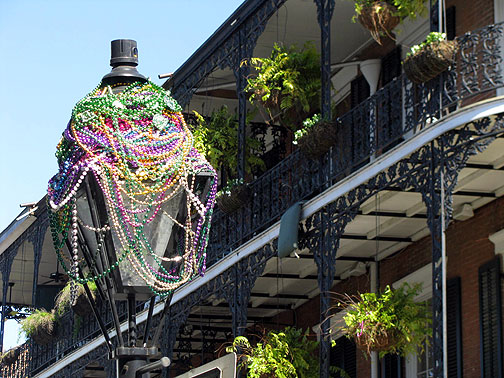
Beads cover street light in French Quarter, just after Mardi Gras 2009.
Just two nights earlier on Thursday in San Francisco we’d strolled over to Revolution Cafe to hear Rupa, Dave Mihaly and some other musical friends jamming in what they called “Family Style.” Sitting there that night, I thought, “this is what’s coming, the Depression will lead us all back to the cafes and bars, where we will hang out with friends, drinking and talking, where self-entertainment and cozy hang-outs will replace commodified entertainment.” The music that has animated New Orleans for its entire life is rooted in the curious combination of poverty and pleasure that grips its population. People here know how to eat, how to play, how to make music, and much more. But it’s the grinding poverty that means as I walk through the neighborhood near my hotel there are at least a dozen talented musicians and dancers busking along my way. It’s the poverty that gave rise to jazz and the blues, those musical genres that whip through our brains, bodies, and hearts to elicit so many feelings and thoughts all at once! I almost cried listening to the rendition last night of Ray Charles’ “Georgia” even though I didn’t think it that spectacular musically. Something just hit me. And the jubilation, the euphoria, that grows in your heart listening to these guys banter, and then jam, and then the individual solos soaring over the communal bedrock… it’s incredibly moving.
New Orleans is probably a good template of how things are developing… monied tourists safely protected in certain zones while the rest of the city is considered off-limits and too dangerous to even visit. The city is a model for gated communities everywhere, a phenomenon well known in places like Sao Paulo and Mexico City, but increasingly common in the U.S. too. Someone managed to plant this reminder on a French Quarter wall:
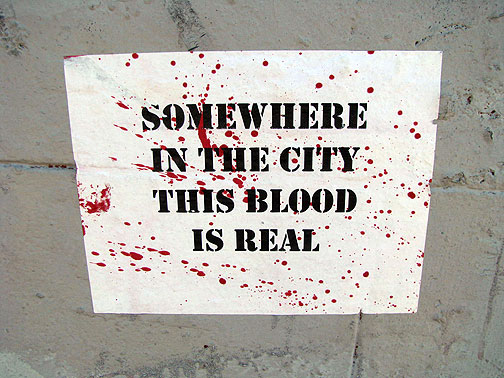
Posted in the French Quarter, March 1, 2009... 11 people were shot on Mardi Gras in New Orleans.
As the Depression’s icy grip extends its hold on more and more people, we are left with each other, with our own talents and our ability to share them. What else is there? Money is a fiction. Property and assets too… We are the movers and shakers and the planet is our home. The stunning architecture of parts of New Orleans are reminders of an earlier era of craftsmanship and care for detail. Walking around San Francisco can awaken similar feelings of fake nostalgia and false memory… But it’s true that the way things were designed prior to our era were rooted in a different sense of aesthetics, a different sense of obligation to create beauty for those around, a different sense of what was worth putting effort (and in our world, money) into… So I love getting to know, even briefly, a city as beautiful as this, while gaining also an appreciation for what was lost here thanks to Sothern’s account. Creeping monoculture is always lapping at the boundaries of beauty, but New Orleans so far has kept it from swamping it entirely. Even after Katrina, the city retains some of its unique energy and charm. The local paper commented that the just-past Mardi Gras offered proof to the locals that the city was recovered, not lost to the floodwaters of destruction… it may never be what it was, but it can still be an amazing place.
Here’s some more photos for the visual charm:
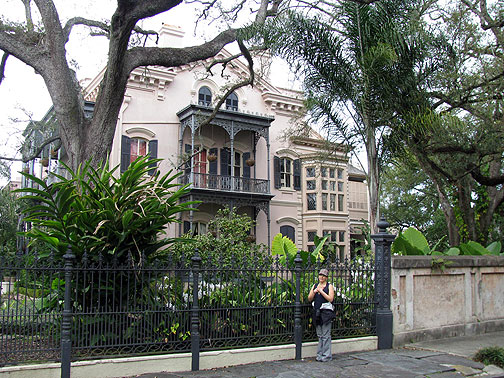
We decided this is our house in some alternate reality!

A lot of crumbling but glorious old houses surrounded by amazing yards.
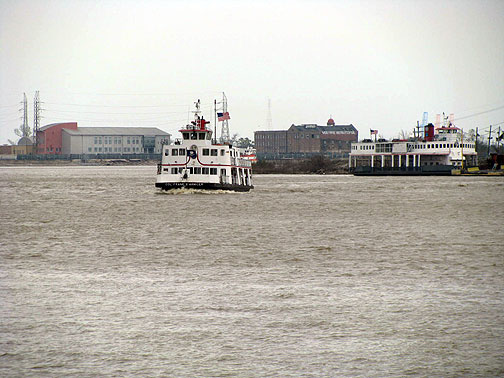
The Mississippi is just at hand, and the ferries still ply its waters amidst countless barges and freighters too.
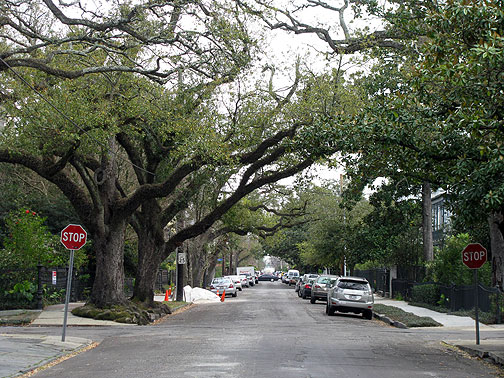
Gotta love old oak trees providing a canopy over your street!












Leave a Reply